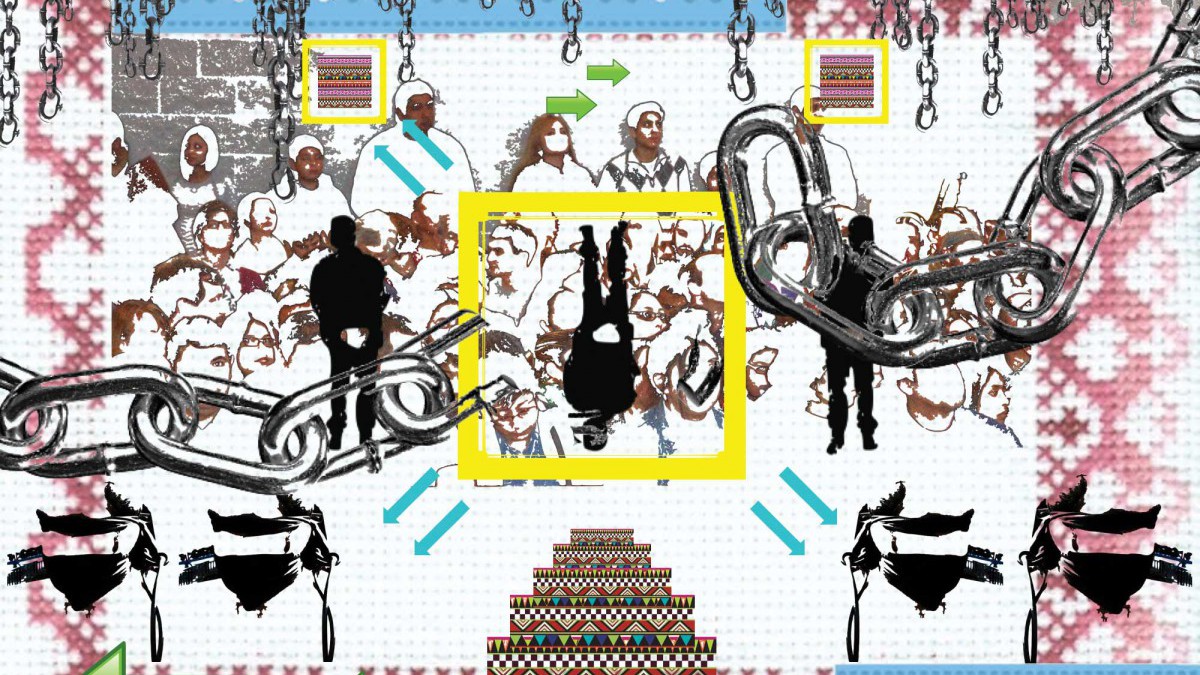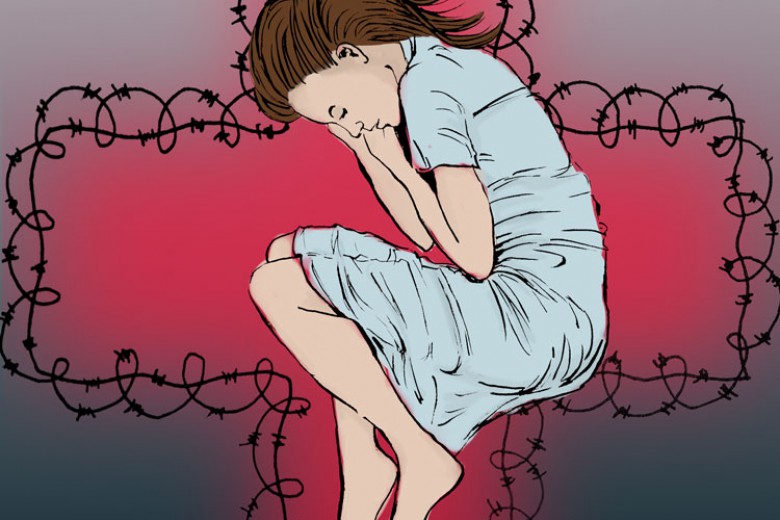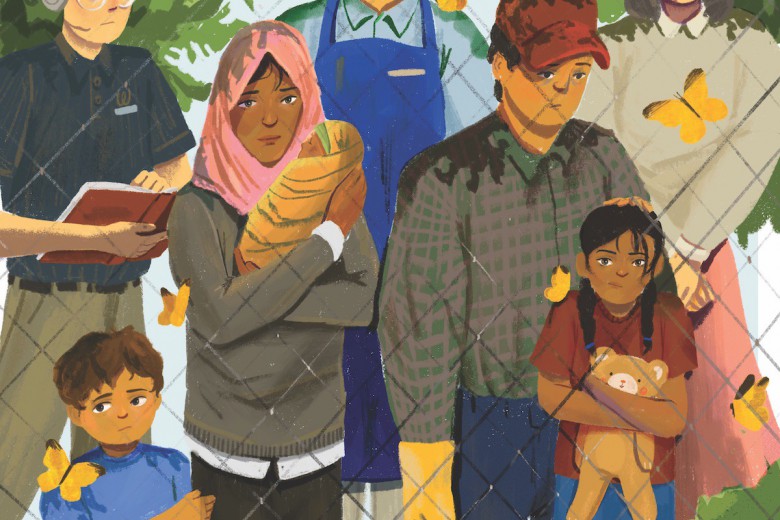Late one evening in the summer of 2015, “Jared”* witnessed the shooting of his cousin in the parking lot of his Toronto apartment building. He called the police and agreed to help them with the investigation. After taking his testimony, the police thanked him and offered him a ride back to his car.
While Jared awaited his ride, officers were running his information through the Canadian Police Information Centre, a database used by both local police forces and the Canada Border Services Agency (CBSA). When the police discovered that Jared did not have citizenship status, things quickly changed. They took him to the Toronto Immigration Holding Centre, where he was detained for almost three months. Jared eventually accessed legal counsel and successfully fought the grounds for his detention, but many others who are detained are deported or remain in immigration detention indefinitely.
“I’ll never ever, ever, ever go to the police again, even for the smallest thing,” Jared says.
Jared is one of an estimated 500,000 people living in Canada without immigration status, at least 200,000 of whom are believed to live in the Greater Toronto Area. A structural shift toward temporary labour, combined with racist, classist, and Islamophobic immigration processes, anchor migrants in conditions without pathways to citizenship. Non-status migrants, fearing the possibility of being discovered and reported to the CBSA, are forced into precarious employment and denied access to life-sustaining services.
In 2014, Toronto city council declared itself a “sanctuary city.” The first of its kind in Canada, the policy promised “access without fear” (AWF) to municipal services for all residents, regardless of immigration status. Toronto is among the sanctuary cities, counties, and campuses committed to a spectrum of policies that limit the gathering of immigration information and co-operation with federal immigration authorities.
In recent months, however, the political stakes of offering sanctuary to migrants have come sharply into focus. Nativist, anti-immigrant, and fascist politics are rearing their ugly heads in both Canada and the U.S, and sanctuary cities are being squarely targeted. While not unprecedented, the political terrain is drastically shifting. Hate speech is being defended as free speech. Refugees are not victims of war, but are being recast as potential terrorists. Apparently, the further you are from citizenship, the closer you are to criminality.
Given the ascent of the right, what can we learn from the histories and contemporary revivals of sanctuary cities as a political tactic in order to create a public and civic culture of solidarity from the ground up?
In the U.S., Donald Trump has vocally opposed sanctuary spaces, vowing to block all federal funding to cities, counties, and universities that offer sanctuary, and sanctioning coordinated national immigration raids. Islamophobia is also rampant in Canada: in late January, six Muslim men were killed while praying – for praying – inside Quebec City’s largest mosque. Conservative Party leadership candidates are speaking at fascist pep rallies (disguised as free speech rallies), and people are preaching hate in front of mosques. While counter-protests often overpower these demonstrations, it is clear that anti-immigrant, right-wing populism is boiling over into the mainstream.
Given this ascent of the right, what can we learn from the histories and contemporary revivals of sanctuary cities as a political tactic in order to create a public and civic culture of solidarity from the ground up? How can the provision of sanctuary threaten the status quo rather than reinforce it?
A brief history of sanctuary
Jennifer Ridgley, a geography and environmental studies professor at Carleton University, notes that the “sanctuary politics that we’re familiar with can actually be traced back to the Vietnam War, when churches, faith-based organizations, and even the city of Berkeley, California, provided sanctuary to soldiers who were refusing to fight.” As many as 40,000 war resisters also sought sanctuary in Canada, largely settling in Vancouver, Toronto, and Montreal.
Sanctuary was revived in the 1980s to support refugees from Central America, mainly from Guatemala and El Salvador, who were displaced by violent U.S.-backed militaries and governments. The Reagan administration classified those migrants as “economic migrants” rather than refugees fleeing state violence, thereby denying many the ability to claim asylum.
Comprised of a loose network of over 500 churches, synagogues, faith-based organizations, and migrants, the sanctuary movement in the U.S. focused on providing transportation, housing, legal aid, and occasionally physical protection in the form of asylum in churches. Meanwhile, municipal governments in Los Angeles, San Francisco, and Chicago passed early iterations of sanctuary city policies, which attempted to limit the gathering of citizenship information and remove immigration status as a requirement to access municipal services.
The sanctuary movement expanded its political mandate beyond direct support to oppose U.S. military and geopolitical intervention. “And so it was a two-pronged approach,” explains Ridgley, “to try to provide support to precarious migrants but at the same time trying to address the reasons why people were forced to leave their homes in the first place.” While the national movement quieted in the 1990s after the U.S. government opened more pathways to residency for refugees, the moral imperative and political tactic of sanctuary would soon be revived again.
In Canada, between 1983 and 2003, 36 migrants invoked sanctuary. Of those, 21 gained legal status (the remaining cases were unknown, or resulted in deportation or going underground). Canadian sanctuary networks also play an integral role in the U.S. movement’s attempt to help refugees denied access to the U.S. get to the Canadian border, and then to facilitate refugee claims and provide further support.
Following 9/11, sanctuary re-emerged in response to the groundswell of anti-immigrant politics and legislation. Since then, over 300 cities, counties, and campuses have become part of this loosely coordinated “New Sanctuary Movement” across the U.S., largely in response to grassroots organizing of community-based migrant justice movements. The wide range of sanctuary spaces across the country has resulted in what the Immigrant Legal Resource Center calls a “spectrum of sanctuary”: variegated policies that, to different extents, limit the time and resources local bodies can spend assisting federal immigration enforcement in the discovery, arrest, and detention of migrants.
The New Sanctuary Movement and its Canadian parallels have won important policy shifts in favour of migrant rights. But with recent intensification of Islamophobia and anti-immigrant sentiments, sanctuary spaces are increasingly threatened by their respective federal and provincial governments and hostile corners of civil society.
Since then, Toronto, Hamilton, Vancouver, and Montreal have taken up the symbolic status, and following Trump’s election, organizers in smaller cities like Winnipeg, London, Guelph, Fredericton, Edmonton, Saskatoon, and Regina are also determining how they can meaningfully provide sanctuary.
Attack on sanctuary
The New Sanctuary Movement and its Canadian parallels have won important policy shifts in favour of migrant rights. But with recent intensification of Islamophobia and anti-immigrant sentiments, sanctuary spaces are increasingly threatened by their respective federal and provincial governments and hostile corners of civil society.
In Canada, Conservative Party leadership candidate Kellie Leitch has coasted on her anti-immigrant platform, which includes a proposal to screen immigrants for “anti-Canadian values.” The last votes in the U.S. were still being counted when Leitch proclaimed that Trump’s election represented an “exciting message that needs to be delivered in Canada as well.” Two days before that election, many Canadians indicated a similar attitude: an Ipsos poll for Global News showed that 76 per cent of Canadians said they were “likely to consider” a similar platform to Trump’s in the next election, while a Nanos poll concluded that 75 per cent supported strengthened screening for immigrants from Middle Eastern countries.
Anti-immigrant and Islamophobic attitudes cannot be dismissed as “fringe” in the Canadian context. Recently, the far-right Rebel Media, led by conservative Ezra Levant, organized a sold-out “freedom rally” in Toronto in opposition to motion 103 (M-103), which proposes that the Canadian government recognize the need to “quell the increasing public climate of hate and fear” and “condemn Islamophobia and all forms of systemic racism and religious discrimination.”
“Hate is a human emotion,” said Levant in front of hundreds of attendees. “You have the fundamental charter right … to hate something.” Levant later challenged: “I don’t believe we should have religious discrimination, but what’s that got to do with Islamophobia?”
Levant was joined that evening by Conservative Party leadership candidates Leitch, Chris Alexander, Brad Trost, and Pierre Lemieux, who all expressed their opposition to the motion condemning Islamophobia.
Not a month following the event, the Canadian Coalition of Concerned Citizens (CCCC) nationally coordinated a “March for Freedom” in 65 Canadian cities to protest M-103, claiming it was the harbinger of Sharia law. The rallies were, for the most part, quite small, and CCCC protesters were outnumbered by counter-protesters in Toronto and Montreal committed to proving that anti-immigrant racism is not welcome in the places they live.
From sanctuary to solidarity
Many migrants in Canada face a stark reality. Stories of children removed from their classrooms by immigration enforcement, workers stopped on their morning commute and deported, mosques and homes vandalized, frequent police profiling and “status checking” of people of colour, and limited access to social services demonstrate the extent to which the most vulnerable people in our communities are left to fend for themselves in a society that paints them as undeserving of the human rights offered to citizens.
Attempts to create more welcoming environments for immigrants are being led at the local level. “Encouraging other cities to do what we’ve done in the city of Toronto I think is very important,” Toronto city councillor Kristyn Wong-Tam says, “because it actually puts more pressure on the federal government and the province to have a more progressive view on the issues around immigration, refugees, and non-status people.”
But while the growing network of sanctuary cities in Canada is creating a strong symbolic platform upon which issues of migrant rights can be discussed nationally, it is simply not enough for cities to line up and “affirm” their commitment to welcoming immigrants. The real work is to translate municipal policy into daily practice.
What would this look like? Front-line city staff would be trained on how to navigate a “don’t ask, don’t tell” mandate, police forces would cease collaboration with the CBSA, services would be accessible, and municipalities would encourage other levels of government to follow their lead.
And this implementation is not happening yet.
“We have the shell, but we haven’t really filled the shell with what we need,” says Toronto city councillor Joe Mihevc.
This is where celebrated sanctuary city policies like Toronto’s are flawed, and the notion of “sanctuary” itself is misleading. Fred Tsao, a longtime immigrant rights advocate in Chicago, recognizes that there is “a misconception that these [sanctuary] communities are places where immigration authorities cannot operate, which is not the case.”
Even since adopting the policy, non-status migrants do not feel safe accessing city services. A recent report by No One Is Illegal–Toronto revealed that the Toronto police were calling the CBSA and inquiring about nearly 100 individuals’ immigration status a week.
Despite the hopeful labels of “sanctuary,” migrants still live in daily fear. This reality becomes painfully clear in stories like Jared’s.
Sanctuary policies only prohibit city services from gathering immigration information and actively co-operating with immigration authorities – except when required by law. They do not actively protect precarious or non-status migrants from detention or deportation, or from police acting like immigration officers. And so activists and grassroots organizers must continue to fight against policies that allow immigrant communities to continue to be over-surveilled and under-served despite the city’s promise of sanctuary.
In Toronto, the coalition responsible for pressuring the city organizes under the banner “Solidarity City,” which long-time migrant justice and Indigenous solidarity organizer Craig Fortier says, “put[s] mutual aid at the forefront of the politics and pushe[s] back against the reformist idea that a simple civic policy was going to be enough to achieve justice.”
In Toronto, cultivating sanctuary initially was not focused on politicians and city bureaucrats. Farrah Miranda, an organizer with No One Is Illegal–Toronto, notes, “we imagined the AWF campaign as a means to organize in places where people gather to build a stronger, more organized migrant justice movement that would effectively fight and win status for all.” This concept of sanctuary is not rooted in traditional hierarchies of power, but in people engaging in mutual aid and building community power from the ground up.
Front-line city staff would be trained on how to navigate a “don’t ask, don’t tell” mandate, police forces would cease collaboration with the CBSA, services would be accessible, and municipalities would encourage other levels of government to follow their lead.
It is precisely in this political moment that we must reimagine sanctuary beyond the limits of city policy. How do we challenge the idea that sanctuary is declared by the state, and conceive instead of sanctuary as rooted in communities defending each other from the state?
Since the state has long underserved racialized migrant communities, many have developed their own networks of mutual aid and solidarity. Efforts to create sanctuary/solidarity cities must therefore honour these communities’ history of resistance and resilience, and strive to create new ways of relating to and caring for each other that do not place the state at the centre.
At its core, sanctuary should be a weapon. It should be a local strategy that resists state-defined categories of “legal” and “illegal” and puts forward a new vision of citizenship and belonging. At its best, a sanctuary/solidarity city can liberate spaces and provide immediate solutions for non-status migrants while connecting these struggles to social movements fighting colonialism, capitalism, patriarchy, and racism.
For Fortier, the potential of a true solidarity city comes when “the greatest power we have is not our sheer numbers, but the gumption we have to act upon our convictions and refuse to obey unjust laws […] At their most dangerous, solidarity city movements will give ordinary people the courage to openly resist injustice and to actively seek out new relationships of consent, respect, responsibility, and care.”
This means we cannot ask for a solidarity city; we must create one ourselves.
Corrections: The editor apologies for several errors that were introduced at the late production stage. In the print version, the sentence, “And so activists and grassroots organizers must continue to fight against policies that allow those in Jared’s situation to be randomly detained” incorrectly characterizes the nature of detention as random. This has been changed online to read, “And so activists and grassroots organizers must continue to fight against policies that allow immigrant communities to continue to be over-surveilled and under-served despite the city’s promise of sanctuary.” Furthermore, the sentence in print that reads, “Between 1983 and 2003, 36 migrants invoked sanctuary,” has been clarified here to read “In Canada, between 1983 and 2003…” Finally, Toronto has been added to the list of cities that have taken up the symbolic status of sanctuary cities. The editor takes responsibility for these errors and sincerely apologizes to the author.







